Items
Tag
protest
-
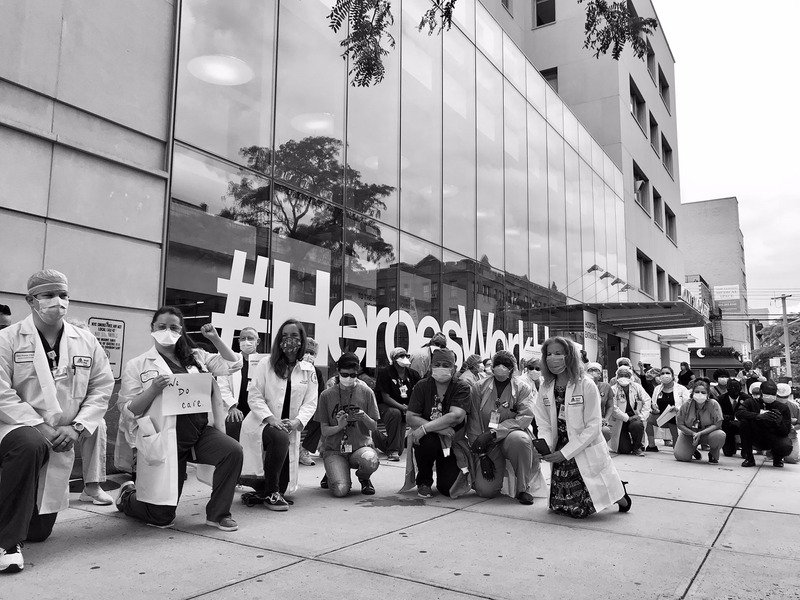 2020-05-02
2020-05-02On A Knee
The photo highlights a peaceful protest that involved the participation of medical faculty. The health care workers included in this photograph included doctors, nurses, admin, security guards and handful of maintenance. This was demonstration to support the Black Lives Matter Movement after the killing of a George Floyd at the hands of a police officer. The individuals in this photo can all be seen taking a knee similar to the protest method used by Colin Kaepernick. National Football League, player Colin Kaepernick took his first knee on September 1, 2016. The taking of the knee went against the tradition of standing during the signing of the National Anthem. Kaepernick said at the time: “I am not going up to show pride in a flag for a country that oppresses black people and people of color”. The people in this picture felt the same exact sentiments as Kaepernick. I chose this source because I wanted historians to understand the impact of the pandemic and the unity it created amongst individuals of different races. As a health care worker, I faced the challenges of Covid-19 directly. The fear of transmitting COVID-19 led to months of isolation from my loved ones. This feeling of loneliness contributed to the decline of mental health for me and many of my co-workers. On May 25, 2021, when George was murdered by a Minneapolis police officer over a suspicion of a counterfeit $20 bill my feeling of loneliness grew tremendously. Being an African American man in the united states was now just as dangerous as the virus killing thousands in New York. When the members of my staff came up the idea of protesting for the rights of African Americans, my feeling of loneliness begin to fade. Kneeling on the ground next to coworkers of all different races reminded of the inclusiveness and unity that we all needed in life. This was a moment in a history that will never be forgotten. -
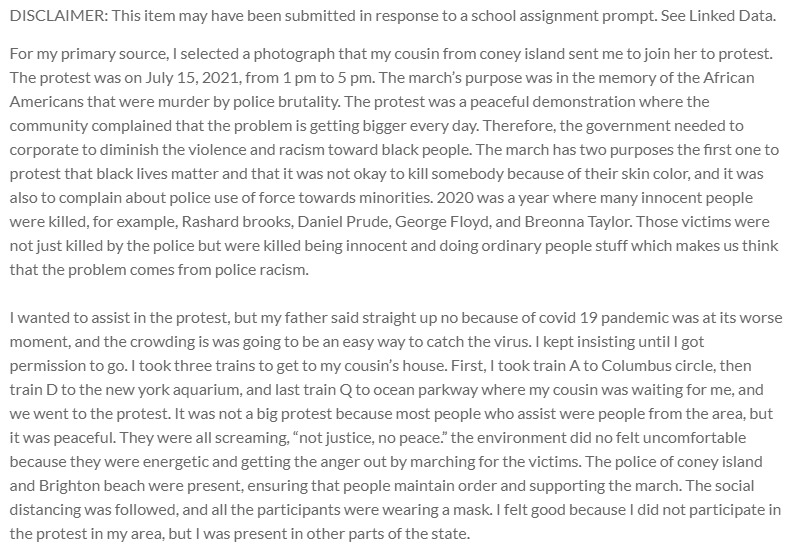 2020-07-15
2020-07-15Coney Island Police Brutality Protest
For my primary source, I selected a photograph that my cousin from coney island sent me to join her to protest. The protest was on July 15, 2021, from 1 pm to 5 pm. The march’s purpose was in the memory of the African Americans that were murder by police brutality. The protest was a peaceful demonstration where the community complained that the problem is getting bigger every day. Therefore, the government needed to corporate to diminish the violence and racism toward black people. The march has two purposes the first one to protest that black lives matter and that it was not okay to kill somebody because of their skin color, and it was also to complain about police use of force towards minorities. 2020 was a year where many innocent people were killed, for example, Rashard brooks, Daniel Prude, George Floyd, and Breonna Taylor. Those victims were not just killed by the police but were killed being innocent and doing ordinary people stuff which makes us think that the problem comes from police racism. I wanted to assist in the protest, but my father said straight up no because of covid 19 pandemic was at its worse moment, and the crowding is was going to be an easy way to catch the virus. I kept insisting until I got permission to go. I took three trains to get to my cousin’s house. First, I took train A to Columbus circle, then train D to the new york aquarium, and last train Q to ocean parkway where my cousin was waiting for me, and we went to the protest. It was not a big protest because most people who assist were people from the area, but it was peaceful. They were all screaming, “not justice, no peace.” the environment did no felt uncomfortable because they were energetic and getting the anger out by marching for the victims. The police of coney island and Brighton beach were present, ensuring that people maintain order and supporting the march. The social distancing was followed, and all the participants were wearing a mask. I felt good because I did not participate in the protest in my area, but I was present in other parts of the state. I selected this source because I want historians of the future to analyze that the country was active and acting against the problem. Racism is a global problem. It can be controlled if we unify and try to make others conscious that it is not okay to judge somebody else because of the way they look or their nationality. The communities were getting together to announce that they needed our support to solve the problem and eliminate conflicts with people equal like us but with a tiny skin color difference. Racism is so intense that people need to go outside in the middle of a pandemic to protest and moderate the issue. We were exposed to the virus because the violence toward minorities is increasing in the country. It looks like the only way it can be moderate is by going outside to show the dominant group that we have a voice. -
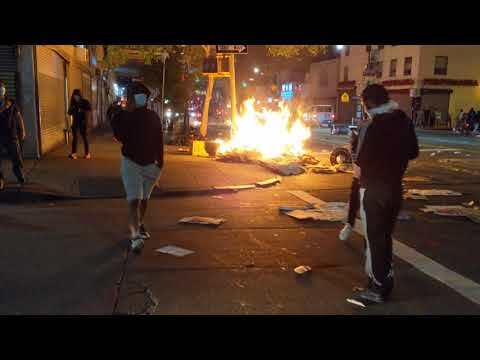 2020-06-02
2020-06-02Mayhem at Fordham Road
A video of the riots that took place in Fordham Road during summer of 2020. -
 2020-05-30
2020-05-30Civil Discourse During A Pandemic
I assume like many New Yorkers, March 13th through 18th was when things really changed. It did for me on the 15th of March 2020 or the ides of March as I like to remember it. My store shut down for what seemed like 2 weeks. Of course, soon I would be given the news we would be shut down completely. I already knew where things were going, at the time I worked at an Asian restaurant, so I was hearing many of the conversations about China then. But I could not have predicted what would happen next. As slow and dreadful as 2020 was, things were moving at lightning speed for the situation we experienced. It felt like every few days something new would arise and test our nation. I selected these pictures because it shows how tired everyone is, the blank faces of people who are following orders, while the other side expresses their hardships all the while wearing masks, the bane of 2020. I want the historian of the future to know that no matter the situation at hand, many of us will still protest for what was wrong even if they got sick. It didn’t matter because we needed to send a message. The two images that you see in the beginning were taken by my friend, Emilio Lopez, who documented the protests, riots, and clashes between police in the summer of 2020. I did not go to the early protests because of covid and the violence/looting wasn’t the things I wanted to be a part of. I remember face-timing my friend to make sure if he was alright as I did not go with him. What he described to me that was happening in the parts of Fordham, and Union Square areas. Emilio had said many of the protesters were young men who were bored of the lockdowns and needed to do something exciting. There were fires, baton exchanges with the cops, and then the looting started. It all got a little too ugly for the whole week of George Floyd protests in New York. One of my close friend’s stores in Fordham was destroyed as a result. The images were taken right before things took a violent turn at Union Square. Where many of my friends were tear-gassed and beaten by cops to disperse when the first lockdown was getting implemented. Those two images, I feel like the body language of the subjects conveys how I felt about the lockdowns, the social injustice, in general about 2020. These were the first few weeks of protests that took place in the wake of George Fyold murder. I was shocked and scared when the masses went on to the streets because of the sheer amount while the pandemic was still going on. I hope the historians of the future can understand us even if they have to go through a cluster of memes from this era, real pictures with real human emotions will always speak louder I believe, and that civil rights in this country still have ways to go. -
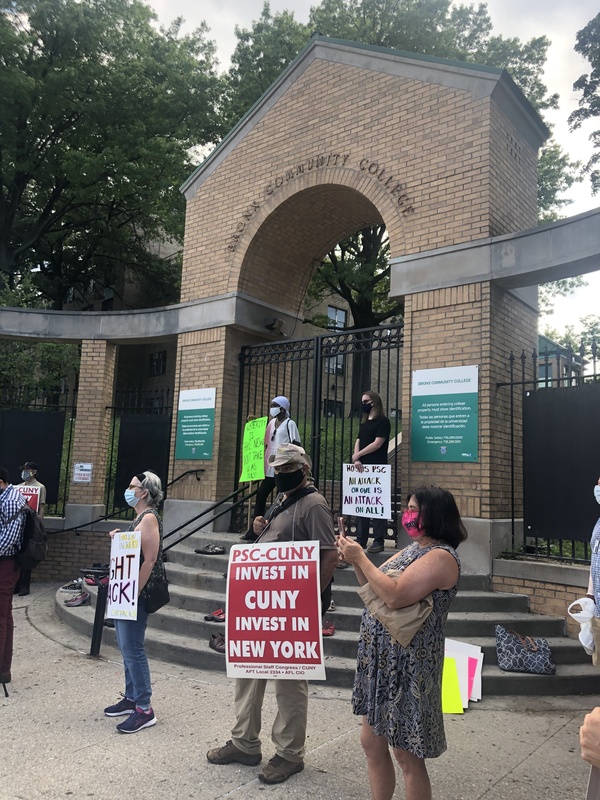 2020-07-15
2020-07-15PSC-CUNY Protest at BCC
For my primary source, I selected a photograph I took at a protest held in front of the Bronx Community College campus on July 15, 2021. The Professional Staff Union of CUNY (PSC-CUNY), the union for the faculty and much of the staff throughout CUNY, organized the event to protest the BCC administration June 26 decision to lay off 36 experienced adjunct professors at the end of their 3-year contracts, even though that their departments recommended that they be rehired. People in the picture include BCC Faculty, staff, and students, as well as those from as well as people from Hostos Community College, who came to support the BCC community and were facing similar cuts. The day was very hot, but I was nervous to the subway because of COVID, so I rode my bike from my home (about 24 miles roundtrip). I was pretty sweaty and probably stinky when I arrived. It was the first time I had been to campus since March 10, when, on my way home from school on the subway, I learned CUNY was moving online. (The campus itself was locked, but we stood in front of the gate on University.) It was also the first time I people from school in person since March; I was so happy to talk to them. It was weird to be with a group people, after months of isolation, but we all wore masks and stood six feet apart. Cars honked their support as they drove by. I selected this source because I want historians of the future to understand how the pandemic hit higher education and the connections among the COVID crisis, social justice movements, and education. Although I went to larger marches after the murder of George Floyd, I believe funding for CUNY is a form of social justice. I was angry that politicians and school administrators were giving lip-service to the phrase Black Live Manners, while cutting funding and jobs from CUNY. BCC’s students are overwhelmingly Black and Latinx, and many studies show that a CUNY education is one of the best schools for supporting social mobility, helping people support themselves and their families. Firing the adjuncts not only meant the teachers lost their income, and, sometimes, their health insurance, but that BCC students would be in larger classes; larger classes mean faculty have less time to devote to each student, which can make it harder to for students to succeed. While I understood enrollment was down and the budget from the city and state would likely be smaller because of the economic toll of the pandemic, I thought there were other places the administration could cut costs. (Such as their own salaries). I want historians to see that the faculty and staff of CUNY fought for what their students deserved and the connections among CUNY, social justice, and New York’s economic recovery. I also want them to see how people approached protests, which require gathering together with other people and often chanting or shouting, while in the middle of a pandemic that required people to stay apart and cover their mouths. -
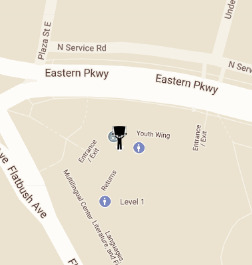 2020-10-11
2020-10-11The Justice for George Floyd Information Map
As a librarian who works alot with maps, I am very impressed with this site: Justice for George Floyd. This is a way for anyone who wants to protest in the greater NYC area to keep track of upcoming and past events. You can also sign up and add your own events, which will then appear with a description link and an appropriate protesting icon on the map. -
2020
New Challenges, New Hope
Ever since the start of the pandemic and the shift towards remote learning, I’ve faced new challenges in places I did not expect. In my home, it was hard getting used to studying and going to class whilst living in a small apartment that I share with my family; I did not having adequate space to learn and read, but my family and I worked something out and now I could/can study with ease. Additionally, I could not talk to my friends and interact with them, even online, given how I had to focus 2x more on my studies but I realized that my friends were experiencing the same thing and we soon planned several days to just talk online and interact. With COVID-19 and police violence spreading like wildfire, I feared what was going to happen to my family, friends, professor, class colleagues and more. However, seeing how people got together, helped each other, protested, united and worked in solidarity, it showed me something: hope. That even in the hardest times in life, there is still hope. -
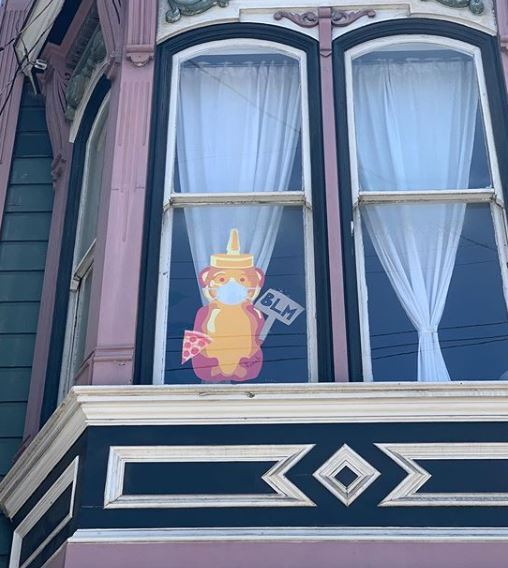 2020-07-11
2020-07-11Honey Bear Hunt in San Francisco
Across San Francisco, honey bears wearing masks - created by the artist fnnch - are popping up on storefronts and in resident's windows. The message is clear, "Please wear a mask. It's simple." The featured bears are masked versions of the Bowie Bear, the Bowtie Bear, the Classic Bear, the Pizza Bear holding a BLM sign, the Love Bear near a sign that reads "Hey Honey! Let's stick together." and the Avocado Bear. The originator of this post is also wearing a Honey Bear mask created by fnnch and included a photo of his mask collection that sits near his front door.
